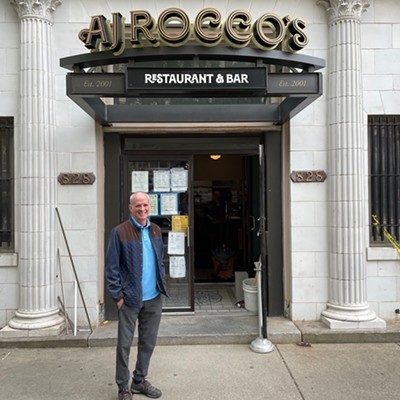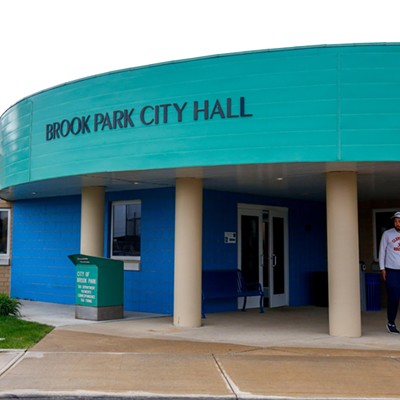All righty, then.
There's nothing implicitly wrong with finding a new use for gallery floors, and there's certainly nothing wrong with working within a minimalist aesthetic, as do all of these artists. If Eva Hesse could work wonders with rubber and cheesecloth, why not the artists here with painted puzzle pieces, soap, and dried rose petals?
The answer is that minimalism, which toys with the idea of doing more with less, can in the wrong hands look like an attempt to reinvent the wheel. Slow transformation of simple materials is the name of the minimalist game, and the pleasure--assuming the game is played well--comes from detecting tiny variations in nearly monochromatic frameworks. Because so much is riding on these revelations, all fails if the artist can't pull them off. Choosing the right variation, the one which speaks volumes, is the tough part, and a misstep in this area is often fatal. Much of Floored is dead on arrival.
Finding meaning in seemingly innocuous objects is a pressing concern for Leslie Roberts, a Brooklyn artist with a degree from Yale. Currently fascinated with the possibilities of painting on jigsaw puzzle pieces, in Floored she works with color and pattern in an attempt to turn these symbols of childhood escapism into a metaphor for sophisticated artistic capers. The attempt to endow puzzle pieces, which have nearly uniform shapes, with mysterious qualities is about par for the minimalist course. This tendency to intellectualize the mundane is what Philip Glass detractors are lampooning when they accuse the prolific composer of aspiring to convince the world that he has rediscovered the C-major scale.
"587 Pieces (-66 + 62)" is an example of such ungarnished strategies. Roberts not only paints blank puzzle pieces in a variety of solid colors ranging from combat-fatigue olive to Life Saver red, she adds mosaic touches that evoke the erotic paintings of twentieth-century Austrian painter Gustav Klimt. In Klimt's paintings, archetypal femmes fatales were surrounded by decorative patterns that some writers have likened to butterfly or peacock wings. Roberts's aim, though, is not to enhance temptresses but to give the gallery floor at SPACES an aesthetic character; the puzzle pieces hug the edges of walls and wind their way around a gallery column. In this fashion, she suggests that the humble puzzle piece can articulate space just as a painting or a sculpture can.
Of course, if Glass could create an opera called Einstein on the Beach, Roberts has the right to put as many puzzle pieces on the floor as she wishes. But while there was something undeniably comic about Glass's four-hour extravaganza--which often seemed to include everything except Einstein in a Speedo--Roberts's efforts more readily call to mind the scientist's impenetrable mathematical equations. In spite of its superficially sensual trappings, "587 Pieces" is a painfully austere exercise, and the Klimt allusion proves to be a red herring. Where the Austrian master's bits of mosaic enhanced the hot-blooded ambiance of his work, there's no such payoff in Roberts's bone-dry creation.
In an accompanying artist's statement, Roberts suggests that painting on jigsaw puzzles might be thought of as silly, but then defends the practice by noting that art in general can often be thought of as silly and that, at least for the moment, working with puzzles allows her to "combine formal strategies with pure play and visual pleasure." Of course, combining "pure" play with formal strategies is one way of making "pure" play look a lot like tedium.
Rhode Island artist Cynthia Swanson enters the floor show with "Clean, Clean, Clean, Clean, Clean . . .," a work that is about--surprise--obsession. She transforms the gallery floor by covering black and white tiles with translucent soap, which is caught between the cracks of the tiles and piles up in one corner, giving the piece the faint smell of an apartment house laundry room. The surface of the tile has been washed so much that it's now coated with a soapy film; the soap collected in one corner in turn suggests that the process of washing threatens to obliterate the tiles altogether. Like some crazed lizard in a B-grade horror flick, this soap is going mad and threatens to destroy everything in its path.
"Clean" successfully stimulates thought about the supposedly benign rituals surrounding washing. One imagines Swanson washing the tiles obsessively, and as a result, the piece takes on some of the attributes of those endurance pieces so prevalent in performance art wherein artists subject themselves to extreme heat or dehydration in order to illustrate a point. The prevailing image is that of Swanson, huddled over the tile floor, scrubbing away in a Sisyphean struggle to beat Mr. Clean at his own game.
Where Swanson strives to find profundity in scrubbing bubbles, Wendy Hanson of Seattle sets out to explore gender issues, an overtly political mission that only lessens the impact of her work. For instance, several of Swanson's works use stitched and embroidered rose petals, presumably as part of an attempt to cast off once and for all the cliche of flowers as symbols for the female body.
In works like "Weary Bones," the embroidered petals stand in for bones, arms, and other body parts. When doctored rose petals are placed in specimen boxes and arranged with pillows fashioned from old clothes to create a makeshift corpse, one suspects that subversion is the point. Since the specimen boxes remind one of butterfly collectors who kill what they love and mount the same for their viewing pleasure, "Weary Bones" can be viewed as a commentary about what contemporary society does to women.
Other works, like "Corset" (in which river rocks are constrained by corsets in the form of stitched rose petals), seem similarly preoccupied with issues of freedom and imprisonment. But though it couldn't have been easy for Hanson to embroider rose petals, hard work in and of itself doesn't guarantee compelling results. In the end, "Corset" might better have been displayed at a craft fair; at least there its degree of difficulty could have been factored into the final score.
Hanson does considerably better with an elegiac piece called "Bread Box." The work consists of a rusted travel case that's been filled with slices of white bread, each piece bearing the cast image of an impassive buddha or cherubic human face. It's an admittedly disturbing and provocative image, but, sadly, Hanson never really completes the thought. If the point is that companionship is a form of nourishment (hence the equation between bread and faces), this seems an obvious way of stating it. And though Hanson flirts with Duchampian simplicity, resisting the temptation to add further flourishes, those sentimental cherubs ultimately interfere with a good idea.
High on intellectual octane but low on originality is New York City artist Robert Kalka's "Each in Their Own Way," which in its own way recalls the work of sculptor Carl Andre. In the 1960s, Andre placed square sheets of hot-rolled steel adjacent to one another; in these floorbound works, the artist challenged the notion of sculpture as being predominantly vertical. Kalka's medium is a series of about a hundred separate terrariums, each of which consists of a small box containing soil, beans in various stages of sprouting, and a small house that the artist likens to those found in Monopoly sets. The idea is to suggest that each of these environments, though similar in obvious ways, are different in subtle ways. Sure enough, just as families with the fabled 2.2 kids are not uniformly happy, these bean sprouts do not all thrive equally.
Although subtle variations are undeniably important in any attempt to understand the big picture, Kalka doesn't seem to allow for the possibility that all variations aren't the same. It's a problem with most of the works in Floored. Two Big Macs, exactly the same except that one has one splotch of special sauce and the other has two, are certainly different. The question is whether such a difference appreciably alters either object or the relation between them.
One could ask the same thing about Roberts's puzzle pieces or Hanson's embroidered rose petals. Kalka's terrariums, though intended as a cry for tolerating people's differences, succeed only in making everything seem the same. Like so much of the failed minimalism in Floored, they accept conformity even as they claim to question it.
Floored, through June 18 at SPACES, 2200 Superior Viaduct, 216-621-2314.











